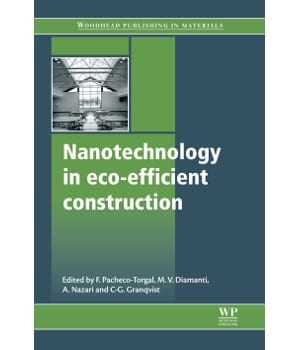 Nanotechnology in Eco-Efficient Construction
Nanotechnology in Eco-Efficient Construction
Edited by Fernando Pacheco-Torgal, M. V. Diamanti, A. Nazari, and C. Goran-Granqvist
Hardcover / eBook
ISBN: 9780857095442 / 9780857098832
456 pages
€180
Click here for more information
Reviewed by Professor Onuegbu Ugwu, University of Nigeria
Nanotechnology has become a buzzword for researchers, academics, and other captains of industry. The term nanotechnology had early humble beginning in 1959 when Feynman gave his seminal speech ‘There’s Plenty of Room at the Bottom – an Invitation to Enter a New Field of Physics’. However, it has evolved into a global push-pull technology that is now the focus of several industries and sectors. This has, resulted in the current global race by countries to be at the forefront of nanotechnology.
But there are few textbooks that discuss theory and/or application of nanotechnology in construction. On the other hand, construction contributes to climate change. As an illustration, the global infrastructure space is purported to be worth 57.3 Trillion Dollars for the 20-year period ending 2030. It covers several infrastructure categories such as buildings, roads, rail, ports, airports, power, water and telecom, all of which require inputs of several construction processes that transform various products into the desired physical artifact. These activities and processes cumulatively generate perturbations and turbulence in the ecosystem. Thus, there is need for books that discuss innovative solutions that mitigate such impacts on the environment and eco-system.
The book “Nanotechnology for eco-efficient construction” contributes to fill the existing gap. The contributing authors discuss the subject from multi-dimensional perspectives. There are sixteen chapters in the 443 page book. The chapters are arranged in three parts.
Part I (Chapters 2-7) discusses infrastructure applications. The importance of infrastructure in societal growth and economic expansion is well documented in literature However, there is an overarching need for sustainable infrastructure delivery through innovative design, construction, operation and maintenance and demolition. Chapters 2 to 7 respectively discuss the following topics; application areas such as cement-based materials, high performance concrete (HPC), self-cleansing concrete, steel, Asphalt, and safety issues as they relate to use of nanomaterials in construction.
Part II (Chapters 8-12) discuses applications for building energy efficiency. The respective topics covered in the chapters include; coatings for eco-efficient buildings, high performance thermal insulation material, energy-efficient windows, switchable glazing technology, and third-generation photovoltaic (PV) cells. Finally Part III (Chapters 13-16) discuss photovoltaic applications such as; concrete mortar and plaster, self-cleansing tiles and glasses (smart tiles and glasses), paints for eco-efficient buildings and domestic water purifications.
The book is very informative and it has been published just in time. It is noteworthy that the Intergovernmental Panel on Climate Change (IPCC) released IPCC Report on Climate Change 2014, at the end of the 1st quarter of 2014. The IPCC report described the impacts of global warming as “severe, pervasive and irreversible”. This is a clear indication of the need for eco-friendliness in all human activities including construction and associated processes. The book discusses various ways nanotechnology-driven construction process innovation can contribute to mitigate the impacts of such activities. These include climate change engendered by upstream processes in the construction supply chain such as high energy consumption and emissions from cement manufacture.
The book gives a panoramic view of Nanotechnology applications in construction at various levels of detail. It is also very expository and gives specific interesting statistical data. Chapter 1 makes a very good business case for nanotechnology in construction. It highlights the various efforts countries are making to be at the forefront of research and development on the application of nanotechnology in different thematic areas. China is purported to occupy 2nd position in terms of research publications. This reflects China’s strategic huge investment in research, development and dissemination (RD&D). It is not unlikely that this would translate into real economic windfall benefits, if and when China becomes the world factory for the manufacture and distribution of nanomaterials.
The book covers various aspects of nanotechnology including nanomaterials and nanoscience. However, it only discussed aspects related to life cycle analysis and costing very briefly, subsuming it in the chapter on safety issues (Chapter 7). Such an important topic deserves more in-depth analysis and discussion than presented in the book. The book’s focus on eco-construction, its depth of coverage, and style of writing by various contributing authors makes it understandable by readers at various levels. Researchers, educators, captains of industry, and policy makers would find the book interesting and useful.

















